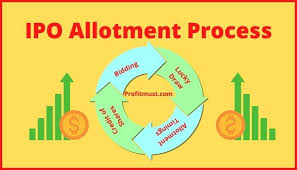
In the exciting world of Initial Public Offerings (IPOs), one crucial aspect that often puzzles investors is the share allotment process. If you’ve ever wondered how shares are distributed to eager investors during an IPO, you’re in the right place. This guide will walk you through the intricacies of IPO share allotment in India, helping you navigate this complex process with confidence.
Why is Understanding Share Allotment Important?
Before we dive into the details, let’s consider why this knowledge is crucial for investors:
- It determines your ownership stake in the company
- It affects your potential returns on investment
- It helps you make informed decisions about participating in IPOs
- It allows you to navigate the IPO market more effectively
Key Terms to Know
Before we unravel the allotment process, let’s familiarize ourselves with some essential terms:
- Minimum Application: The smallest amount you can invest in an IPO, usually around ₹15,000.
- Minimum Subscription: The minimum number of shares that must be applied for in an IPO (typically 90% of the total shares offered).
- Oversubscription: When a company receives more applications than it can allot.
- Lot Size: The fixed number of shares in each application unit.
The IPO Allotment Process: Step by Step
Now, let’s break down the allotment process:
- Application Submission: Investors apply for shares through their bank or broker.
- Bid Collection: The registrar collects and categorizes all bids.
- Share Allocation:
- For retail investors (investing up to ₹200,000), shares are often allotted through a lottery system if oversubscribed.
- For larger investors, shares are typically allotted proportionately.
- Allotment Finalization: The registrar finalizes the allotment based on SEBI guidelines.
- Refund Processing: Excess money is refunded to investors who didn’t receive an allotment or received fewer shares than applied for.
Allotment Scenarios
Let’s explore two possible scenarios:
Scenario 1: Undersubscription
If the total number of bids is less than the total number of lots offered, everyone gets the number of lots they bid for. Simple, right?
Scenario 2: Oversubscription
This is where it gets interesting. If the IPO is oversubscribed:
- Every bidder is allotted at least one lot (if possible).
- Remaining lots are allotted proportionately based on the number of lots each investor bid for.
- If proportional allotment isn’t feasible, a computerized lottery determines the winners.
The Role of Lot Size
Understanding lot size is crucial. Here’s a quick example:
Let’s say Company ABC offers 10 lakh shares in their IPO, with each lot containing 10 shares. The total number of lots would be:
Total No. of Lots = Total No. of Shares / Total No. of Shares in One Lot
= 10,00,000 / 10
= 1,00,000 lotsRemember, as a retail investor, you’ll always bid in terms of lots, not individual shares.
Who Decides the IPO Price?
The IPO price is determined by the underwriter (usually an investment banking firm) based on factors like:
- Company financials
- Past performance
- Future growth potential
- Industry growth rate
- Competitor performance
- Expected demand for shares
The price is typically given as a range (e.g., ₹800 to ₹1,000) to allow the public to decide the company’s worth through the book-building process.
Checking Your Allotment
Once the allocation is done, you can check the registrar’s website to verify your allotment. The IPO Basis of Allotment document, released by the registrar, contains information about the demand for the stock and the allotment details.
Conclusion
Understanding the IPO share allotment process is crucial for any investor looking to participate in the exciting world of new public offerings. By familiarizing yourself with these concepts, you’ll be better equipped to make informed decisions and maximize your investment potential.
Remember, while the allotment process can seem complex, it’s designed to ensure fair distribution of shares among all interested investors. Happy investing!
Disclaimer: This blog post is for informational purposes only and should not be considered as financial advice. Always conduct your own research and consult with a qualified financial advisor before making investment decisions.

